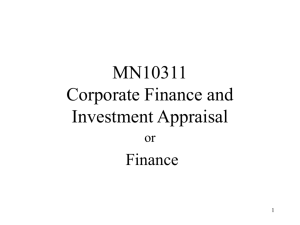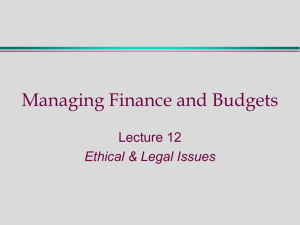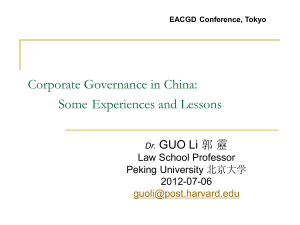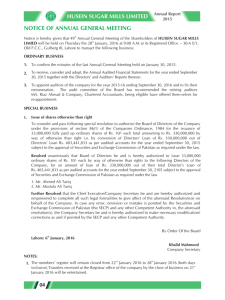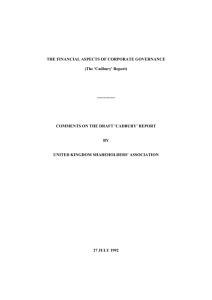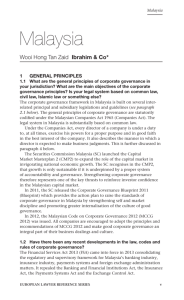Chapter 1 Financial Management and Financial Objectives
advertisement
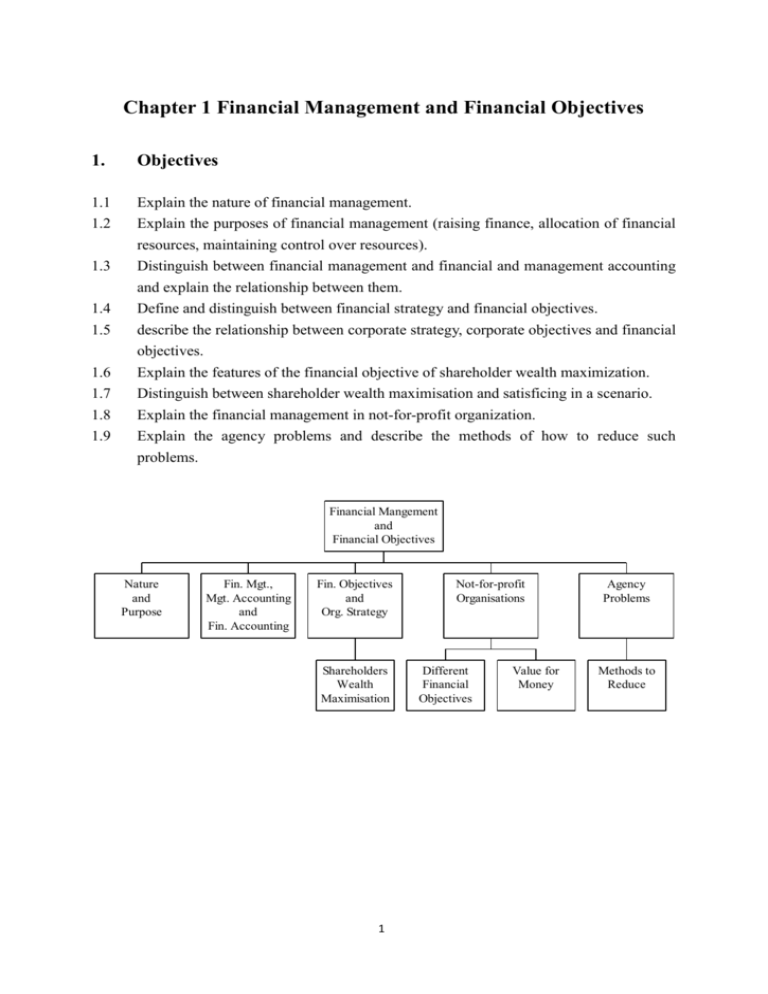
Chapter 1 Financial Management and Financial Objectives 1. Objectives 1.1 1.2 Explain the nature of financial management. Explain the purposes of financial management (raising finance, allocation of financial resources, maintaining control over resources). Distinguish between financial management and financial and management accounting and explain the relationship between them. Define and distinguish between financial strategy and financial objectives. 1.3 1.4 1.5 1.6 1.7 1.8 1.9 describe the relationship between corporate strategy, corporate objectives and financial objectives. Explain the features of the financial objective of shareholder wealth maximization. Distinguish between shareholder wealth maximisation and satisficing in a scenario. Explain the financial management in not-for-profit organization. Explain the agency problems and describe the methods of how to reduce such problems. Financial Mangement and Financial Objectives Nature and Purpose Fin. Mgt., Mgt. Accounting and Fin. Accounting Fin. Objectives and Org. Strategy Shareholders Wealth Maximisation 1 Not-for-profit Organisations Different Financial Objectives Value for Money Agency Problems Methods to Reduce 2. 2.1 The Nature and Purpose of Financial Management KEY CONCEPTS a. b. c. Financial management – can be defined as the management of the finances of an organization in order to achieve the financial objectives of the organization. The usual assumption in financial management for the private sector is that the objective of the company is to maximize shareholders’ wealth. Financial management decisions cover investment decisions, financing decisions, and dividend decisions and risk management. Financial control – the control function of the financial manager becomes relevant for funding which has been raised. Are the various activities of the organization meeting its objectives? Are assets being used efficiently? To answer these questions, the financial manager may compare data on actual performance with forecast performance. 2.2 2.3 2.4 2.5 The financial manager makes decisions relating to investment, financing and dividends. The management of risk must also be considered. Investments in assets must be financed somehow. Financial management is also concerned with the management of short-term funds and with how funds can be raised over the long term. The retention of profits is a financing decision. The other side of this decision is that if profits are retained, there is less to pay out to shareholders as dividends, which might deter investors. An appropriate balance needs to be struck in addressing the dividend decision. Examples of different types of investment decision: Decisions internal to the business enterprise Decision involving external parties Disinvestment decisions Whether to undertake new projects Whether to invest in new plant and machinery Research and development decisions Investment in a marketing or advertising campaign Whether to carry out a takeover or a merger involving another business Whether to engage in a joint venture with another enterprise Whether to sell off unprofitable segments of the business Whether to sell old or surplus plant and machinery The sale of subsidiary companies 2 2.6 The statement of financial position and financial management: 3. Financial Management, Management Accounting and Financial Accounting 3.1 Management accounting Financial management is mainly concerned with making decisions for the long-term future of the company. It involves making forecasts for the future and needs much external information (e.g. knowledge of competitors). The purpose is to make decisions which end up achieving the objectives of the company. Once the long term decisions have been made, they need to be implemented and controlled. This is management accounting. (a) (b) 3.2 Management accounting involves making short-term decisions as to how to implement the long-term strategy and involves the setting up of a control system in order to measure how well objectives are being achieved in order that corrections may be made if necessary. It tends to be short-term, and involves both past information and forecasts for the future. Financial accounting (a) Financial accounting is the reporting to stakeholders – primarily shareholders – of how the company has performed and therefore effectively how well the financial manager and management accountant are doing their jobs. (b) The financial accountant is fulfilling a legal requirement to report the profits, and it is not their role to look for ways of performing better – that is 3 the job of the financial manager. (c) The financial accountant is only looking at past information and information internal to the company. 4. Financial Objectives and Organizational Strategy 4.1 The financial manager needs to decide on strategies for the raising of finance, for the investment of capital, and for the management of working capital. However, before he can decide on these strategies he needs to identify what the objectives of the company are. The following diagram is the key to understanding how financial management fits into 4.2 4.3 overall business strategy. The distinction between 'commercial' and 'financial' objectives is to emphasise that not all objectives can be expressed in financial terms and that some objectives derive from commercial marketplace considerations. 4 4.4 Shareholder Wealth Maximization (a) Most companies are owned by shareholders and originally set up to make (b) money for those shareholders. The primary objective of most companies is thus to maximise shareholder wealth. (This could involve increasing the share price and/or dividend payout.) Shareholder wealth maximisation is a fundamental principle of financial management. You should seek to understand the different aspects of the syllabus (e.g. finance, dividend policy, investment appraisal) within this unifying theme. 5 4.5 Maximising and satisficing One problem for the financial manager is to satisfy the objectives of several stakeholders at the same time. For example, reducing wages might increase profits and might satisfy shareholders, but would be unlikely to satisfy employees. Therefore, in practice a distinction must be made between maximising and satisficing. (a) (b) Maximising – seeking the best possible outcome Satisficing – finding a merely adequate outcome. 5. Objectives in Not-for-profit Organizations 5.1 Not-for-profit organizations include organizations such as charities, state health service and police force, where they are not run to make profits, but to provide a benefit. 5.2 5.3 5.4 5.5 Although good financial management of these organizations is important, it is not possible to have financial objectives of the same form as for companies. The focis therefore for these organizations is on value for money, i.e. attempting to get the maximum benefits for the least cost. Value for money can be defined as getting the best possible combination of services from the least resources, which means maximising the benefits for the lowest possible cost. This is usually accepted as requiring the application of economy, effectiveness and efficiency. Economy is attaining the appropriate quantity and quality of inputs at lowest cost to achieve a certain level of outputs. For example, the economy with which a school purchases equipment can be measured by comparing actual costs with budgets, with costs in previous years, with government/ local authority guidelines or with amounts spent by other schools. 5.6 Effectiveness is the extent to which declared objectives/goals are met. For example, the effectiveness of a school's objective to produce quality teaching could be measured by the proportion of students going on to higher or further education. 5.7 Efficiency is the relationship between inputs and outputs. For example, the efficiency with which a school's IT laboratory is used might be measured in terms of the proportion of the school week for which it is used. 6 6. Stakeholders 6.1 Although the theoretical objective of a private sector company might be to maximize the wealth of its owners, other individuals and groups have an interest in what a 6.2 company does and they might be able to influence its corporate objectives. Anyone with an interest in the activities or performance of a company are ‘stakeholders’ because they have a stake or interest in what happens. It is usual to group stakeholders into categories, with each category having its own interests and concerns. The main categories of stakeholder group in a company are usually the following. Internal: (a) Directors (b) Employees Connected: (c) Shareholders (d) Lenders (e) Customers (f) Suppliers (g) Labour union 6.3 External: (h) Government (i) Society as a whole The influence of the various stakeholders results in many firms adopting non-financial objectives in addition to financial ones. For example, (a) Maintaining a contented workforce (b) Showing respect for the environment (c) Providing a top quality service to custoemrs 7 7. Agency Problem 7.1 Agency conflicts are differences in the interest of a company’s owners and managers. They arise in several ways. (a) Moral hazard – A manager has an interest in receiving benefits from his or her position as a manager. These include all the benefits that come from status, such as a company car, use of a company airplane, lunches, and so on. (b) Effort level – Managers may work less hard than they would if they were the owners of the company. The problem will exist in a large company at middle levels of management as well as senior management level. (c) Earnings retention – The remuneration of directors and senior managers is often related to the size of the company, rather than its profits. Management are (d) (e) more likely to want to re-invest profits in order to make the company bigger, rather than payout the profits as dividends. Risk aversion – Executive directors and senior managers usually earn most of their income from the company they work for. They are therefore interested in the stability of the company, because this will protect their job and their future income. This means that management might be risk-averse, and reluctant to invest in higher-risk projects. Time horizon – Shareholders concern about the long-term financial prospects of their company, because the value of their shares depends on expectations for the long-term future. In contrast, managers might only be interested in the short-term. This is partly because they might receive annual bonuses based on short-term performance, and partly because they might not expect to be with the company for more than a few years. 7.2 Reducing the agency problem – Several methods of reducing the agency problem have been suggested. These include: (a) Devising a remuneration package for executive directors and senior managers that gives them an incentive to act in the best interests of the shareholders. For example, one way to encourage managers to act in ways that increase shareholder wealth is to offer them share options. Share options will encourage managers to make decisions that are likely to lead to share price increases (such as investing in projects with positive net present values), since this will increase the rewards they receive from share options. (b) (c) Having enough independent non-executive directors inside the board. They have no executive role in the company and are not full-time employees. They are able to act in the best interests of the shareholders. Independent non-executive directors should also take the decisions where there 8 is (or could be) a conflict of interest between executive directors and the best interests of the company. For example, non-executive directors should be responsible for the remuneration packages for executive directors and other senior managers. 7.3 Incentive schemes (management reward schemes) The structure of a remuneration package for executive directors or senior managers can vary, but it is usual for a remuneration package to have at least three elements. (a) A basic salary – it needs to be high enough to attract and retain individuals with the required skills and talent. (b) Annual performance incentives – The performance target might be stated as profit or earnings growth, EPS growth, achieving a profit target, etc. Some managers might also have a non-financial performance target. (c) Long-term performance incentives – Which are linked in some way to share price growth. Long term incentives are usually provided in the form of share awards or share options of the company. 9 Examination Style Questions Question 1 At a recent board meeting of Dartig Co, a non-executive director suggested that the company’s remuneration committee should consider scrapping the company’s current share option scheme, since executive directors could be rewarded by the scheme even when they did not perform well. A second non-executive director disagreed, saying the problem was that even when directors acted in ways which decreased the agency problem, they might not be rewarded by the share option scheme if the stock market were in decline. Required: Explain the nature of the agency problem and discuss the use of share option schemes as a way of reducing the agency problem in a stock-market listed company such as Dartig Co. (8 marks) (ACCA F9 Financial Management December 2008 Q1(e)) Question 2 Discuss the relationship between investment decisions, dividend decisions and financing decisions in the context of financial management, illustrating your discussion with examples where appropriate. (8 marks) (ACCA F9 Financial Management June 2010 Q4(c)) 10
